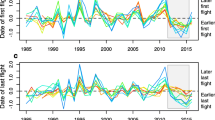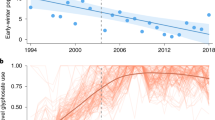Abstract
Changes in butterfly phenology due to climate changes have led to the need for models based on factors other than calendar date to predict butterfly development, allowing those monitoring their populations to increase the effectiveness of field surveys. In this study, we developed two simple climatic models, one using yearly accumulated growing degree days (GDD) and the other using yearly accumulated shortwave radiation flux densities (SRAD), to determine if these variables can predict first emergence of three butterfly species with less error than an approach based on the average ordinal date of first observation at a site. Furthermore, we investigated whether combining our two models would increase our ability to predict the timing of first emergence. We determined that GDD models were better at predicting first emergence than were ordinal date models and SRAD models for all species tested; however, the actual variation among these models was so small that any additional effort required to develop GDD models would not justify their use as a replacement for the simpler ordinal date models at this time, although as climate changes they may become more useful. We also determined that combined models did not improve the ability to predict first emergence.
Similar content being viewed by others
References
Apple JW (1952) Corn borer development and control on canning corn in relation to temperature accumulation. J Econ Entomol 45:877–879
Arnold CY (1959) The determination and significance of the base temperature in a linear heat unit system. Proc Am Soc Hortic Sci 74:430–445
Bristow KL, Campbell GS (1984) On the relationship between incoming solar radiation and daily maximum and minimum temperature. Agric For Meteorol 31:159–166
Buzzee B (2015) Daymet R Shiny: An app that allows users to access interpolated historical weather data. Retrieved from the Github repository at https://github.com/bbuzzee/DaymetRShiny/. Accessed 25 May 2017
Caffrey DJ, Worthley LH (1927) A progress report on the investigations of the European corn borer. USDA Agric Bull 1476:1–155
Cayton HL, Haddad NM, Gross K, Diamond SE, Ries L (2015) Do growing degree days predict phenology across butterfly species? Ecology 96:1473–1479
Cess RD, Zhang MH, Minnis P, Corsetti L, Dutton EG, Forgan BW, Garber DP, Gates WL, Hack JJ, Harrison EF, Jing X (1995) Absorption of solar radiation by clouds: Observations versus models. Science 27:496–499
Corbet PS (1956) Environmental factors influencing the induction and termination of diapause in the emperor dragonfly, Anax imperator Leach (Odonata: Aeshnidae) J Exp Biol 33:1–4
Dell D, Sparks TH, Dennis LH (2005) Climate change and the effect of increasing temperatures on emergence dates of the butterfly Apatura iris (Lepidoptera: Nymphalidae). Eur J Entomol 102:161–167
Dethier BE, Vittum MT (1967) Growing degree days in New York State. Cornell University Agricultural Experiment Station, Geneva
Dirzo R, Young HS, Galetti M, Ceballos G, Isaac NJ, Collen B (2014) Defaunation in the Anthropocene. Science 345:401–406
Dobkin DS, Olivieri I, Ehrlich PR (1987) Rainfall and the interaction of microclimate with larval resources in the population dynamics of checkerspot butterflies (Euphydryas editha) inhabiting serpentine grassland. Oecologia 71:161–166
Ghazoul J (2005) Buzziness as usual? Questioning the global pollination crisis. Trends Ecol Evol 20:367–373
Gilmore EC, Rogers JS (1958) Heat units as a method of measuring maturity in corn. Agron J 50:611–615
Habel JC, Segerer A, Ulrich W, Torchyk O, Weisser WW, Schmitt T (2016) Butterfly community shifts over two centuries. Conserv Biol 30:754–762
Hodgson JA, Thomas CD, Oliver TH, Anderson BJ, Brereton TM, Crone EE (2011) Predicting insect phenology across space and time. Glob Change Biol 17:1289–1300
Holmes RM, Robertson GW (1959) Heat units and crop growth. Canada Department of Agriculture, Ottawa
Iftner DC, Shuey JA, Calhoun JV (1992) Butterflies and skippers of Ohio. College of Biological Sciences, Ohio State University, Columbus
Klockmann M, Kleinschmidt F, Fischer K (2017) Carried over: heat stress in the egg stage reduces subsequent performance in a butterfly. PLoS ONE 12:e0180968
Kuefler D, Haddad NM, Hall S, Hudgens B, Bartel B, Hoffman E (2008) Distribution, population structure and habitat use of the endangered Saint Francis Satyr butterfly, Neonympha mitchellii francisci. Am Midl Nat 159:298–320
Langvatn R, Albon SD, Burkey T, Clutton-Brock TH (1996) Climate, plant phenology and variation in age of first reproduction in a temperate herbivore. J Anim Ecol 1:653–670
Leimar O (1996) Life history plasticity: Influence of photoperiod on growth and development in the common blue butterfly. Oikos 76:228–234
MacKenzie DI, Nichols JD, Lachman GB, Droege S, Royle JA, Langtimm CA (2002) Estimating site occupancy rates when detection probabilities are less than one. Ecol 83:2248–2255
McMaster GS, Wilhelm WW (1997) Growing degree-days: one equation, two interpretations. Agric For Meteorol 87:291–300
Miller P, Lanier W, Brandt S (2001) Using growing degree days to predict plant stages. Montana State University-Bozeman, Bozeman, MT
National Weather Service Climate Prediction Center (2005) Growing Degree Days Explanation. https://www.cpc.ncep.noaa.gov/products/analysis_monitoring/cdus/degreedays/gdd.shtml. Accessed 28 Nov 2017
Neild RE, Seeley MW (1977) Growing degree days predictions for corn and sorghum development and some applications to crop production in Nebraska. Nebr Agric Exp Stn Res Bull 280:1–12
Nufio CR, McGuire CR, Bowers MD, Guralnick RP (2010) Grasshopper community response to climatic change: variation along an elevational gradient. PLoS ONE 5:e12977
Pearson RG, Thuiller W, Araújo MB, Martinez-Meyer E, Brotons L, McClean C, Miles L, Segurado P, Dawson TP, Lees DC (2006) Model-based uncertainty in species range prediction. J Biogeogr 33:1704–1711
Rudolph DC, Ely CA, Schaefer RR, Williamson JH, Thill RE (2006) The Diana fritillary (Speyeria diana) and great spangled fritillary (S. cybele): dependence on fire in the Ouachita Mountains of Arkansas. J Lepid Soc 60:218–226
SAS (2017) JMP 12.0.2. SAS Institute, Inc., Cary, NC
Smith R, Fennimore SA, Orloff S, Poole GJ (2010) UC Pest Management Guidelines. Susceptibility of weeds to herbicide control in onion and garlic. https://www.ipm.ucdavis.edu/PMG/r584700311.html. Accessed 21 Sept 2017
Stefanescu C, Penuelas J, Filella I (2003) Effects of climatic change on the phenology of butterflies in the northwest Mediterranean Basin. Glob Change Biol 9:1494–1506
Stoehr AM, Wojan EM (2016) Multiple cues influence multiple traits in the phenotypically plastic melanization of the cabbage white butterfly. Oecologia 182:691–701
Thornton PE, Thornton MM, Mayer BW, Wilhelmi N, Wei Y, Devarakonda R, Cook RB (2014) Daymet: Daily surface weather data on a 1-km grid for North America, Version 2. Oak Ridge National Laboratory (ORNL), Oak Ridge, TN. https://doi.org/10.3334/ORNLDAAC/1328
Van Dyck H, Van strien AJ, Maes D, Van Swaay CAM (2009) Declines in common, widespread butterflies in a landscape under intense human use. Conserv Biol 23(4):957–965
Walker CL, Anderson MR (2016) Cloud impacts on pavement temperature and shortwave radiation. J Appl Meteorol Climatol 11:2329–2347
Wilson L, Barnett W (1983) Degree-days: An aid in crop and pest management. Calif Agric 37:4–7
Wratten SD, Gillespie M, Decourtye A, Mader E, Desneux N (2012) Pollinator habitat enhancement: benefits to other ecosystem services. Agric Ecosyst Environ 159:112–122
Xiao H, Yang D, Xue F (2006) Effect of photoperiod on the duration of summer and winter diapause in the cabbage butterfly, Pieris melete (Lepidoptera: Pieridae). Eur J Entomol 103:537–540
Zalucki MP (1982) Temperature and rate of development in Danaus plexippus L. and D. chrysippus L. (Lepidoptera: Nymphalidae). Austral J Ent 21:241–246
Acknowledgements
Support for this work was provided by the Department of Natural Resource Ecology and Management at Iowa State University. We thank Jerry Weidmann from the Ohio Lepidopterists for sharing their butterfly survey data with us and Benjamin Buzzee from the Iowa State University Statistics Department for access to and guidance for the application we used to retrieve climate data from Daymet. We also thank Julia Schwager, Sarah Rueger, and Samuel Waite for laboratory assistance. We appreciate additional advice and information provided by Nathan Brockman and Aaron Steil. Finally, we thank Dr. Mary A. Harris, Iowa State University, for her thoughtful comments on an earlier version of this manuscript, and two anonymous reviewers for their additional suggestions. This paper is a product of the Iowa Agriculture and Home Economics Experiment Station, Ames, Iowa. Project Numbers IOW03617 and IOW05561 are supported by USDA/NIFA and State of Iowa funds. Any opinions, findings, conclusions, or recommendations expressed in this publication are those of the authors and do not necessarily reflect the views of the U.S. Department of Agriculture.
Funding
No external agencies provided funding for this work.
Author information
Authors and Affiliations
Corresponding author
Ethics declarations
Conflict of interest
The authors hereby disclose that results of research reported in this manuscript are presented clearly and without fabrication, that this manuscript has not been submitted for publication elsewhere, that it contains no known data or text previously published by others without acknowledgement of same, and that there are no known conflicts of interest with respect to the conduct or publication of the research described herein.
Research involving human and animal rights
This research did not involve human subjects nor informed consent of same, nor did it require approval of an institutional animal care and use committee.
Additional information
Publisher's Note
Springer Nature remains neutral with regard to jurisdictional claims in published maps and institutional affiliations.
Rights and permissions
About this article
Cite this article
Lang, B.J., Widrlechner, M.P., Dixon, P.M. et al. Can climatic variables improve phenological predictions for butterfly species?. J Insect Conserv 24, 375–383 (2020). https://doi.org/10.1007/s10841-019-00212-3
Received:
Accepted:
Published:
Issue Date:
DOI: https://doi.org/10.1007/s10841-019-00212-3




